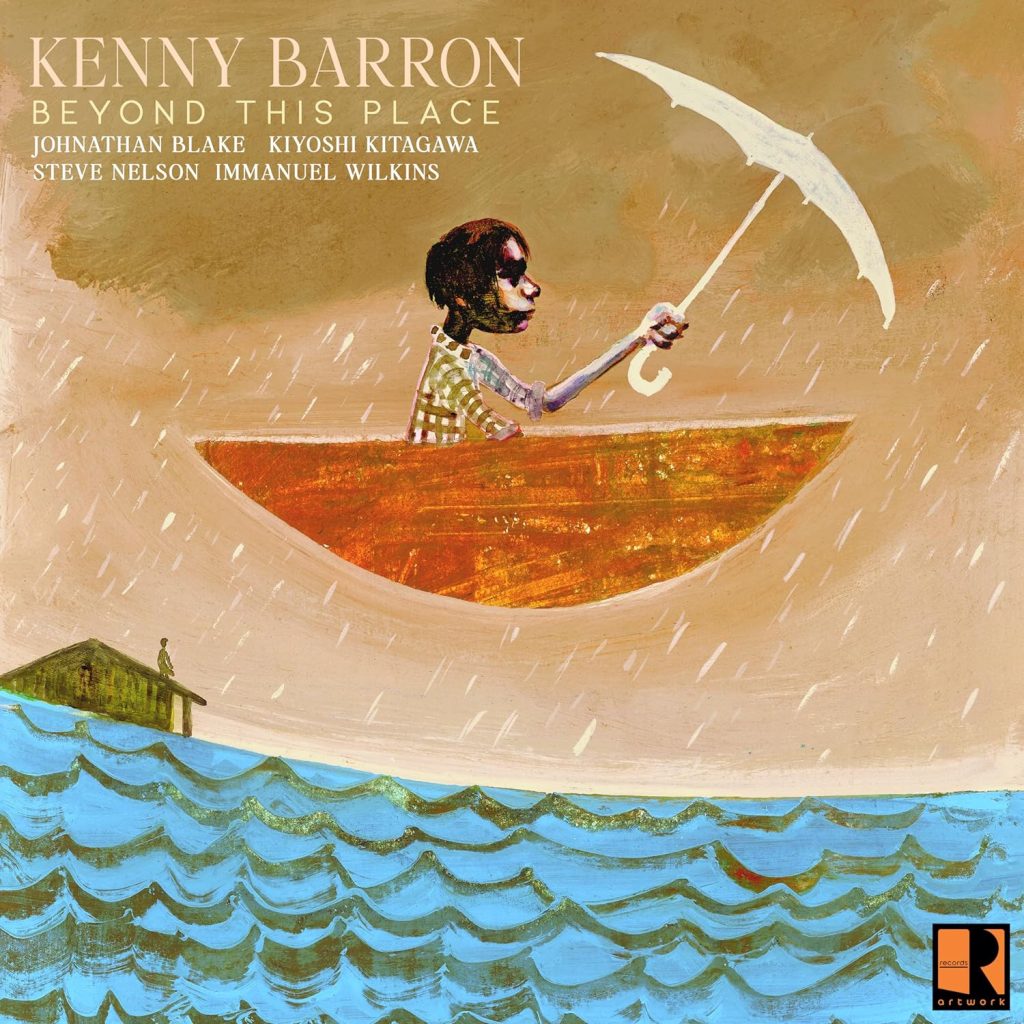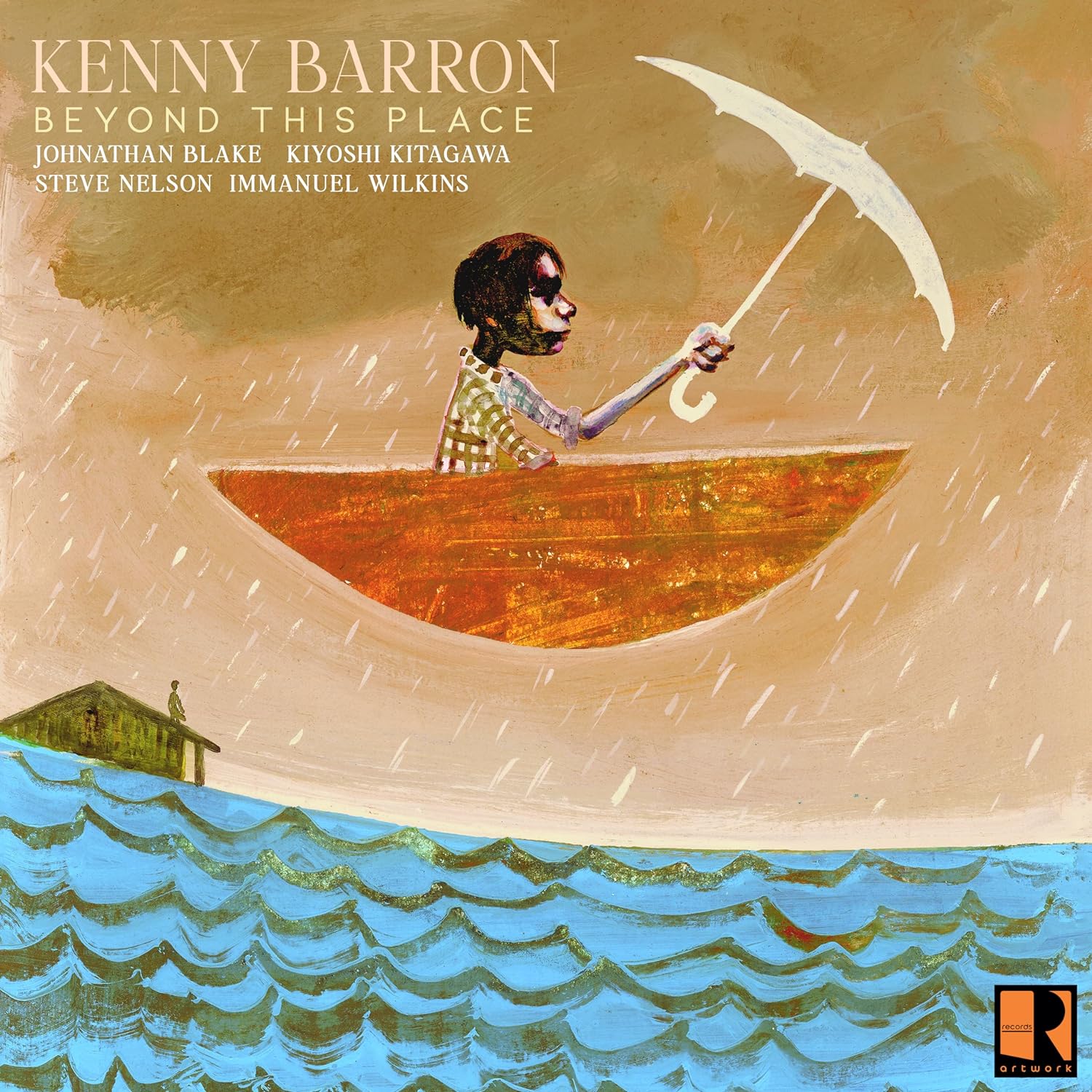Kenny Barron, Immanuel Wilkins, Steve Nelson, Kiyoshi Kitagawa, Johnathan Blake – Beyond This Place
(Artwork Records/ [PIAS]. Album review by Len Weinreich)

Last year, reviewing his previous album release, I described jazz master Kenny Barron as a revered pianist with formidable technique whose style radiates honesty and profundity. Listening to his latest album, Beyond This Place, recorded shortly before his 80th birthday at Midilive Studio in Paris’ northern suburbs, only strengthens my opinion.
Jazz albums from 80-year-old pianists tend to be thin on the ground but Barron seizes the opportunity to consider his career achievements and salute his two most important influences, Tommy Flanagan and Thelonious Monk, with no hint of sentiment or nostalgia.
Surrounded by talent, Barron appears in four varied combinations, two different duos, a quartet and a quintet variously consisting of alto saxophonist Immanuel Wilkins, vibraphonist Steve Nelson, bassist Kiyoshi Kitagawa and drummer Johnathan Blake (worth noting: Barron, Wilkins and Blake were all born in Philadelphia). While five of the tracks are original Barron compositions, he also includes a couple of venerable standards and Blues On Stratford Road, a piece written by drummer Johnathan Blake.
Track one is a quartet version of Hoagy Carmichael and Ned Washington’s The Nearness Of You, written in 1937, a song that never fails to draw couples closer on the dance floor. Barron introduces the theme with quiet, airily spaced chords before the 26-year-old Wilkins effects an impressive entrance on alto. In an interview by Morgan Enos published on the London Jazz News site earlier in 2024, Barron commented “The Nearness of You…was a true test, because (Wilkins) knew how to leave space…and take his time. For me, if you know how to play a ballad, you’ve passed the test. He reminded me so much of Johnny Hodges. His beautiful, soft, sweet sound, and taking space. Sometimes, young people forget that space is a part of music.”
Scratch is a Monkian hommage originally written and recorded by Barron in 1985. Bassist Kitigawa, who has been his musical companion over 20 years, opens the piece before Wilkins surges in like an alto blizzard, spurred by Barron’s asymmetric stabbing at the keyboard like a latter-day Thelonious. The solos that follow are packed with wonder, particularly Steve Nelson and Barron’s complex interplaying with Blake’s churning drumming.
Innocence, an ethereal theme first recorded by Barron in 1978, is introduced by unison alto and piano, producing the mesmerising effect of liturgical incantation. Wilkins, Nelson and Barron intensify the sublime mood and, to finish, offer mesmerising mantra-type repetition.
Johnathan Blake’s Blues on Stratford Road struts its stuff, a deceptively sophisticated blues with tricky key changes, encouraging blues-saturated statements from the three major voices, Nelson’s vibes recalling heavenly echoes of Milt Jackson.
The up-tempo, hard boppish Tragic Magic, according to Morgan Enos’ interview with Barron (link below), “is an original…it’s actually pretty old. I think I only recorded it one time”. Old, maybe, but certainly worthy of revival, it sounds fresh and offers Blake’s longest excursion on drums.
Barron’s comment on the title track, Beyond This Place, is that it “had a kind of spiritual quality to it” is spot on. Its slow, muted, almost sanctified theme spreads a calming effect on every member of the quintet.
When Oscar Hammerstein and Sigmund Romberg wrote Softly As In The Morning Sunrise for the 1928 operetta, ‘The New Moon’, they couldn’t have imagined how popular the song would be in the jazz world. Yet Barron manages to find fresh meaning in a duet with Blake’s inspirational drumming.
In the Enos interview, Barron recalls “Sunset was on my very first recording in the ‘70s. Sometimes, I will record something, and for years, I won’t play it. But I thought it was time to just pull it out and see what happens”. In that case, we’re privileged that, half-a-century later, he remembered the composition and we’re able to hear how it provides inspiration for Nelson and Wilkins.
The final track, We See, was written by Thelonious Monk and poses a question: when a pianist approaches a Monk composition, should that pianist also adopt his highly idiosyncratic style? Barron approaches the issue by alluding to the Monkian style while never attempting an impersonation. It’s treated as a duet with Barron and altoist Wilkins in reflective dialogue.
At the close of the Enos interview, Barron cited the view of another jazz master, Dizzy Gillespie, saying: “Dizzy once said, ‘As you get older, you learn what not to play. Well, I’m 81 years old. I’m still looking; I’m still searching. The whole idea is to play better”. On the evidence of Beyond This Place, he’s doing fine.
The excellent sound quality was achieved through the infinite care of producer, Jean-Philippe Allard who sadly passed away in May this year. Recording and mixing are by Denis Caribaux and mastering by Simon Gibson at St Johns Wood’s Abbey Road Studios.
LINKS: Morgan Enos’s interview with Kenny Barron
Beyond This Place at KennyBarron.com


